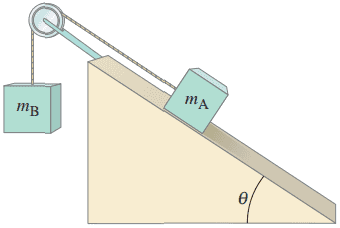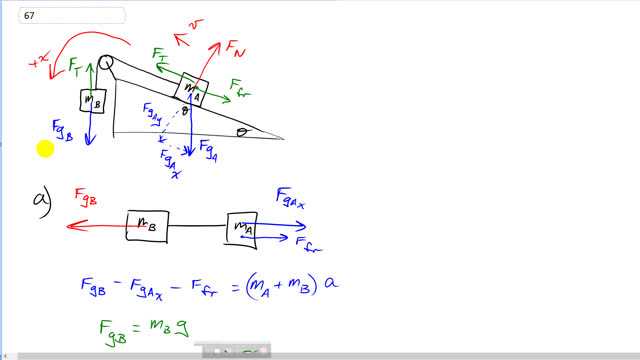
- Suppose the coefficient of kinetic friction between and the plane in Fig. 4–62 is , and that . As moves down, determine the magnitude of the acceleration of and , given .
- What smallest value of will keep the system from accelerating? [Ignore masses of the (frictionless) pulley and the cord.]


In order to watch this solution you need to have a subscription.
This is Giancoli Answers with Mr. Dychko. Block A is on the incline and it's moving up into the left. And we're going to define up to the left and down to be the positive x direction. So, the x axis is kind of going on a curve. We're going to consider this as being one system on the level. You can imagine it this way anyhow. And we'll have two forces pulling to the left on the system. One is the x component of gravity down the ramp and the other one is the force of kinetic friction. And to the right or to the left we have this force of gravity on block B. So, we have force of gravity of block B pulling in the positive x direction, and in the force of gravity x component of block A, and the force of friction of block A pulling in the negative x direction. So, I guess when you write it horizontally like this, it's a little bit confusing because I'm defining my x axis to be positive in to the left which is unusual but anyway, that's how I did it and that's OK. So, these tension forces don't appear on this picture because they are internal to the system. And well, by thinking of two blocks as one unit, we've conveniently reduced it to these 3 forces only. So, we write Newton's second law, the FgB, force of gravity on block B, is positive. And then minus the x component of gravity on block A minus the force of friction that happens to be on block A. And that equals the total mass of the system times acceleration, because this is a net force, it equals ma. But a mass is mA plus mB in this case. And then we create expressions for each of these terms we have FgB is mass of B times gravitational field strength, g. And then the x component of gravity on block A is mA times g times sine of theta because this is the opposite leg of this triangle and so we use sine to get the opposite leg. So, we have mA g sine theta. And then force of friction is the coefficient of kinetic friction times the normal force. And the normal force is going to be equal to the y component of gravity on block A because there's no acceleration off the ramp or into the ramp. And so, the up force has to equal the down force if there's no acceleration. So, a normal force equals y component of gravity. And this is the adjacent leg of the triangle, so, we're going to use cosine theta to calculate that, multiply it by mA g. So, that's what we did here. And then we make substitutions for each of those into our Newton's second law to create an equation that we can solve for a, the acceleration. So, we have FgB is mBg. We have FgAx is mA g sine theta, and then minus force of friction is muK mA g cos theta. And then copy the mA plus mB times acceleration and then we'll solve this for a. We will... What's first? We'll switch the sides around so we have acceleration on the left, and we'll divide both sides by mA plus mB. And we factored out the little g which is a common factor for each of those terms there, so, that's why there's little g bracket everything else left over, all divided by mA plus mB and then substituting numbers and away we go. We have 9.8 meters per second squared times 2.7 kilograms for mass B, minus 2.7 kilograms which is also mass A, times sine 34 degrees, angle of incline, minus 0.15, coefficient of kinetic friction, times 2.7 kilograms times cos 34, all divided by the total mass, and that gives 1.6 meters per second squared and this top part here shows all of that punched into the calculator in case you want to double check your button pushing. And your bracket matching and stuff like that. So, 1.6 is what we get. And then for the minimum coefficient of kinetic friction such that there's no acceleration. Well, we're going to consider this equation for part B, and a is zero if there's no acceleration. And so, it's zero, and so, we can multiply both sides by mA plus mB and then 0 times mA plus mB is still zero. So, this thing just entirely disappears. And by the same token we can divide both sides by little g. And 0 divided by little g is still zero. So, we're left only, once this acceleration is zero we're left with this bracket has to be zero. And then I move this term to the other side, I guess maybe I should write some of this down instead of just saying it because it's actually quite a bit going on there. So, let's make some space. So, we have 0 equals mB minus mA sine theta minus coefficient of kinetic friction times mA cos theta. And then... And so, that's after multiplying both sides by ma plus mB and then dividing both sides by g, and acceleration is zero. And then this thing goes to the left side, and now we're at this line here. And we solve for muK by dividing both sides by mA cos theta. And we end up with this equation. So, the minimum coefficient of kinetic friction to have zero acceleration is going to be 2.7 kilograms minus 2.7 kilograms times sine 34, divided by 2.7 kilograms times cos 34, and that's what we have in the second part of the calculator. And we have 0.53 has to be the coefficient of kinetic friction.